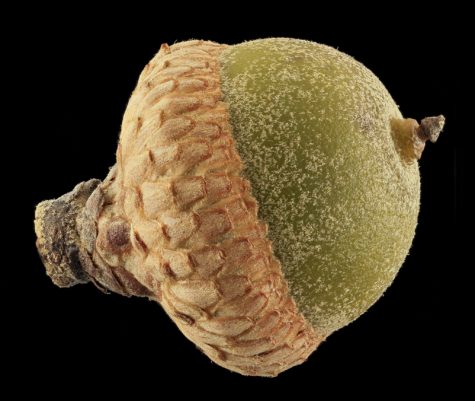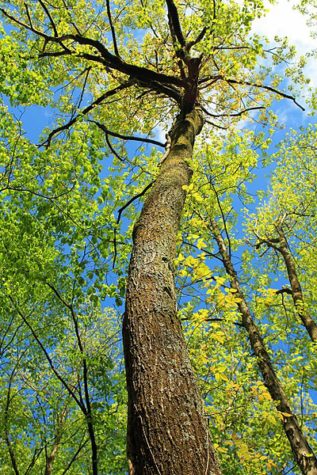 These early fall days have been especially musical here, in my house under the trees. The mornings ding and clink and the afternoons ping and donk and the nights are broken up by knocks, clangs, and cymbal crashes that startle me awake. (Part of my roof is metal.)
These early fall days have been especially musical here, in my house under the trees. The mornings ding and clink and the afternoons ping and donk and the nights are broken up by knocks, clangs, and cymbal crashes that startle me awake. (Part of my roof is metal.)
It’s the acorns falling, but in a relative hail storm rather than the usual drizzle. The massive dumping of seeds and occasional strike on the head might suggest I’ve totally pissed off some squirrels.
But squirrels pretty much just make grumpy noises and twitch their tails when annoyed. Instead, it’s the oaks showing off their progeny, with gravity’s help. The trees are shedding fruit as though it’s their last chance to seed the land.
That’s not too far from the truth. It turns out we are in a mast year—the boom of the boom-and-bust cycle describing oak (and beech) tree reproduction. The trees weighted down with acorns this fall (a big oak might produce as many as 10,000 of them!) will most likely support a much lighter load for the next three to five years. This is a parent tree’s best chance to spread her genes and grow the neighborhood forest before lean times commence.
And they truly make the most of it. Like neighbors filling platter after platter for a block party, oaks synchronize their excess fruit production with other oaks in the area. (This doesn’t surprise me: See my post about plant communication here, and this TED talk about trees’ use of electrical signals. Maybe one of these explains how the plants “get together” on acorn delivery. Or maybe there’s an atmospheric or chemical cue that synchs them up, or something else entirely. No one knows for sure.)
So, why the waxing and waning of resources? You, like me, might quickly assume it has to do with environmental factors like temperature and rainfall. It seems logical that when conditions are good, trees would produce more offspring. Acorns start to develop about two years before dropping, and studies suggest a correlation between masting and summer temperatures during that time—warm the year before a mast and cool two years prior, to be specific.
But masting is not caused by certain weather conditions. What’s more likely, say ecologists, is that the boom-bust cycle evolved as a way to manage seed predation. The hypothesis: A series of lean years helps control the size of seed-predator populations (insects, small mammals with big cheeks, bigger mammals with regular cheeks, plus birds). Then when there’s finally a mast year, with its explosion of acorns—sometimes 100 times more than during a non-mast year—there aren’t so many nibblers as would devour every seed that hits the ground. Acorns that escape predation, along with the ones squirrels bury and forget (silly squirrels!), may actually settle into the soil, send down a root in search of water, send up a shoot in search of light, and eventually grow into trees.
In addition, the cycle may let a tree direct much of its energy, toggling to some degree between growth and reproduction. Tree ring data suggest less growth happens during bumper crop years and vice versa.
 It helps that the oaks go into overdrive together. Not only does that increase the total number of acorns because there are more trees making them, it boosts the efficiency of pollination—potentially improving each individual tree’s own crop. A mast year consolidates a neighborhood of trees’ reproductive energy to get the highest return (seedlings over fat squirrels) for their joint effort.
It helps that the oaks go into overdrive together. Not only does that increase the total number of acorns because there are more trees making them, it boosts the efficiency of pollination—potentially improving each individual tree’s own crop. A mast year consolidates a neighborhood of trees’ reproductive energy to get the highest return (seedlings over fat squirrels) for their joint effort.
Now that I’m thinking about it, last year was rather squirrel deficient in my ‘hood (I notice small animals because my dogs want to eat them all) and the acorn drop was noticeably light. I did much less patio sweeping than I’ve done in recent weeks. And the night music was mostly crickets and car alarms.
As far as Octobers go, I like this year better than last. There’s comfort in the knocks on the roof, the crunch of shells underfoot, the scrabble of creatures in the leaves finding food aplenty. A mast season gives us one last pulse of life before winter comes.
—
Photos:
Acorn: By USGS Bee Inventory and Monitoring Lab [CC BY 2.0 (http://creativecommons.org/licenses/by/2.0)], via Wikimedia Commons
Oak Tree: By Nicholas A. Tonelli from Northeast Pennsylvania, USA (Ferncliff Wildlife and Nature Preserve (6)) [CC BY 2.0 (http://creativecommons.org/licenses/by/2.0)], via Wikimedia Commons
Timely article. If I may be so bold as to ask a kind of self-serving question about some trees I want to plant…
I live in Ireland and the bottom of my garden is lower and damper than the rest. I have a line of willows that have helped a lot, but I’d like to add a few more trees in some more rows – essentially making a miniature wood in back. There’s a company that sells bare-root native trees so it’s not hugely expensive to plant several dozen of them.
The types I was considering were Alder, Asch, Beech and Oak. However I’ve seen the TED tolks you mention here and in other articles and the impression I got was that there was some interspecies communication / resource sharing but there are a number of different sets of them. Looking through books so far I haven’t seen which groupings of trees work best. I was wondering if you could recommend any?
Thanks for any help.
Hello Kevin! I love that you wrote asking for tree advice, but I’m afraid I’m no expert on what combinations are best for tree communication. Certainly groups of a single species will allow for underground “talking”…and I’m guessing maybe oaks and beeches work well together–as I know they often have mast years at the same time. Beyond that, I think you’ll need to check in with one of the scientists giving those fascinating talks! All the best in your planting.
Thank you for explaining why my backyard and deck are buried in beechnuts and acorns.
I aim to inform! (;
Jenny, I’m so glad you wrote this! I’ve been Googling fanatically to see whether 2017 appeared to be a mast year for anyone else. Our various oak trees did this about a month ago, and I was honestly afraid to walk around outside my house during the worst of it. From inside it sounded as though were were under attack, and outside I found myself apologizing to visitors as we ducked and dodged acorn hail. (My two-year-old, however, thinks it was the best thing ever. Every single morning before school she now insists on going out to collect acorns in her little plastic bucket. For Halloween this year, she’s dressing up as an acorn.)
Your daughter the acorn! That’s so wonderful. Thanks for your comment!
Hello,
What part of the world are you writing from? Are mast years regional events? It seems in Niagara they have very few acorns, but a superabundance of black walnuts. Do these cycles occur for every species of tree?
Thanks for the interesting article.
Hi Mark! I’m in the D.C. area and I’ve heard people in neighboring states say they’re experiencing the same thing with the oaks. I believe walnut trees have similar patterns, although some articles I’ve read suggest they alternate more regularly–a big year, then a small one. I have more reading to do to figure this all out, but I’m pleased people are asking about their own areas and species!
In Southern Ontario where I am the oaks and walnuts are both dropping nuts like crazy !
In the Great Lakes region (Chicago/Michigan) I’m seeing large numbers of both walnuts and acorns this fall. I had thought it was my imagination, so thanks for the info!